Income Inequality: USA, France, Finland Comparison Report
VerifiedAdded on 2023/03/20
|12
|2871
|79
Report
AI Summary
This report analyzes income inequality in the USA, France, and Finland, employing the Gini coefficient and Lorenz curve for comparative analysis. The report examines the trends in income inequality within the USA from 1970 to 2014, calculating Gini indices and plotting Lorenz curves for various years. The report further compares the US data with those of France and Finland, highlighting differences in income distribution and identifying potential causes, such as tax policies, government policies, trade unions, and technology adoption. The report also proposes social policies, including reforms in education, employment protection, immigrant integration, and taxation, to address income inequality and enhance upward mobility in the US. The report concludes by discussing the interest of investors, businesses, education policy makers, and trade unionists in income distribution information.
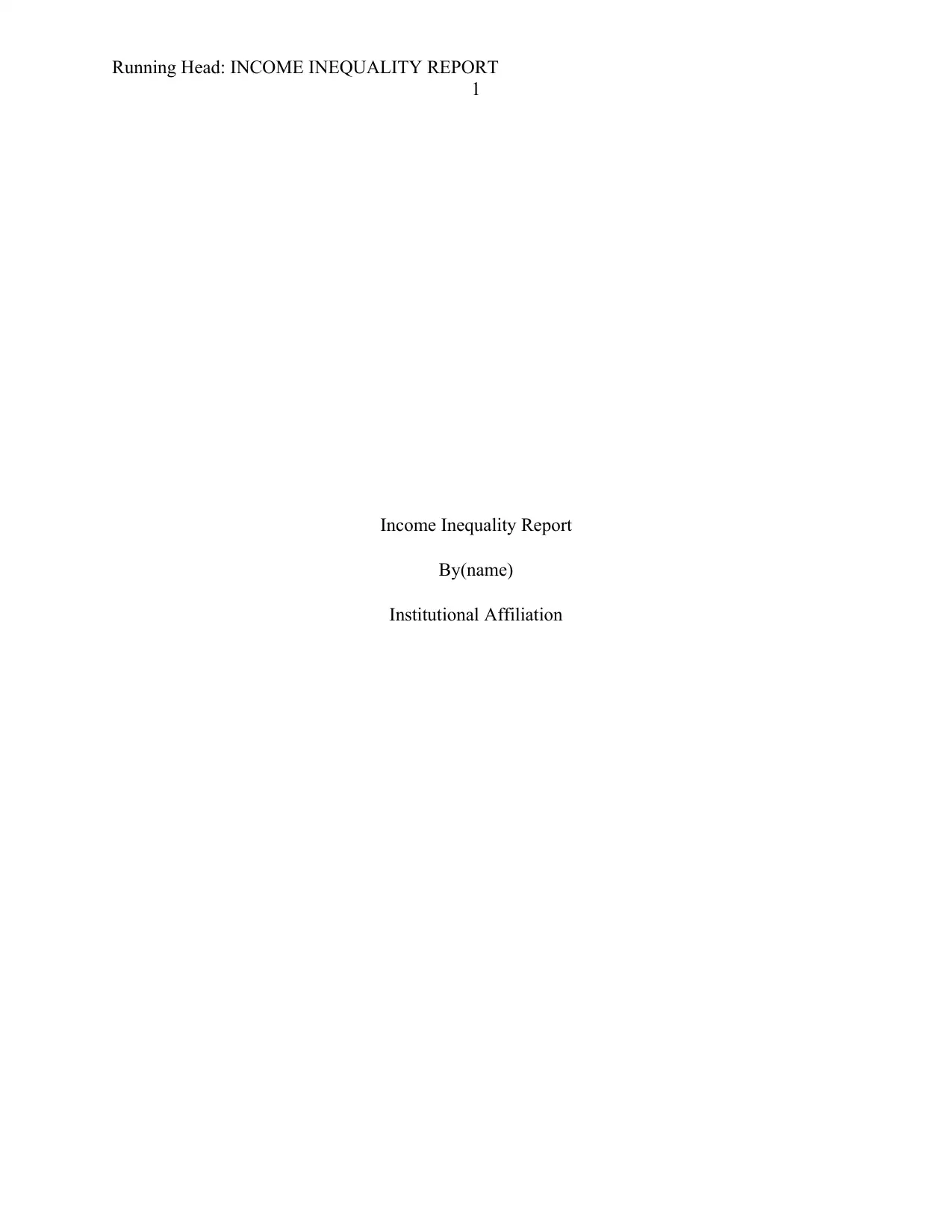
Running Head: INCOME INEQUALITY REPORT
1
Income Inequality Report
By(name)
Institutional Affiliation
1
Income Inequality Report
By(name)
Institutional Affiliation
Paraphrase This Document
Need a fresh take? Get an instant paraphrase of this document with our AI Paraphraser
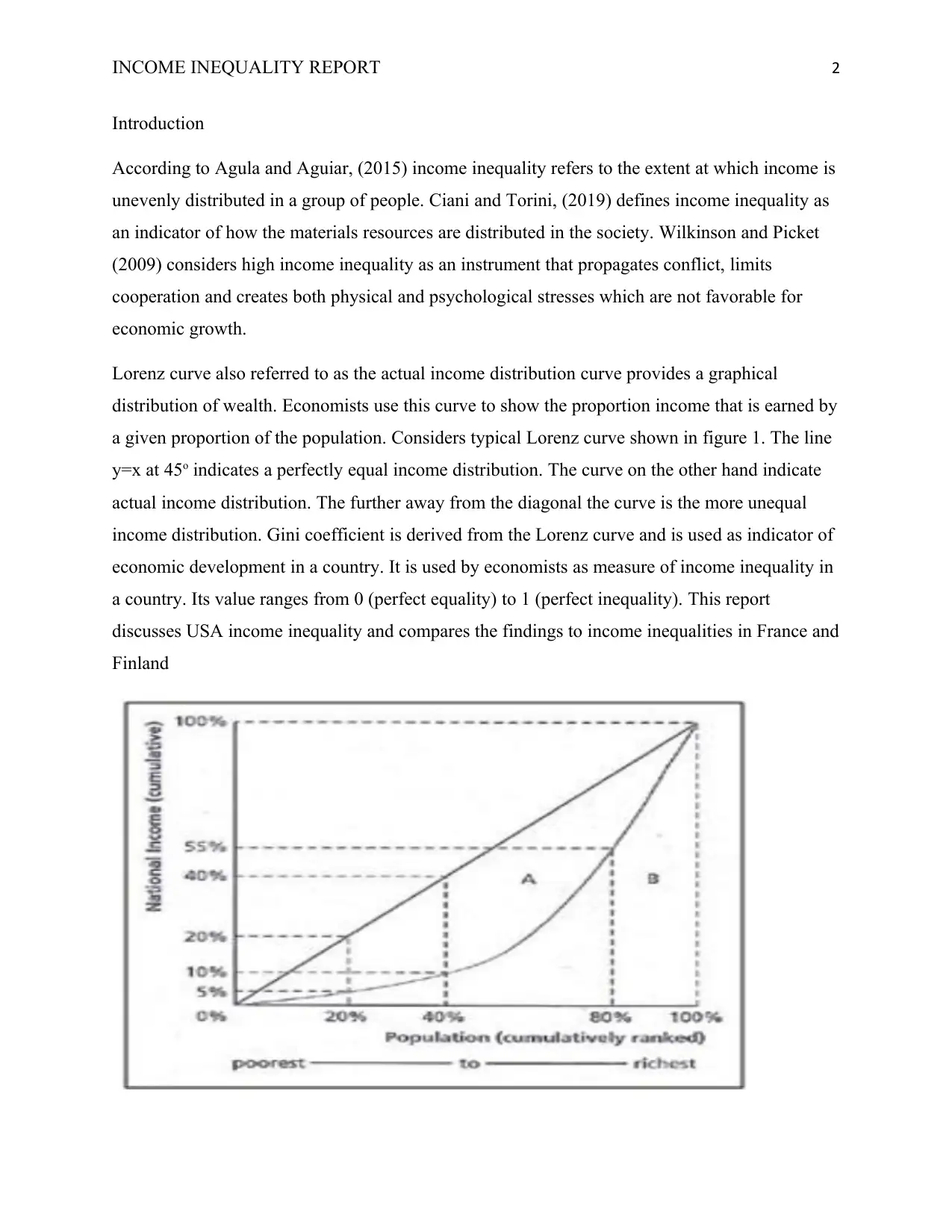
INCOME INEQUALITY REPORT 2
Introduction
According to Agula and Aguiar, (2015) income inequality refers to the extent at which income is
unevenly distributed in a group of people. Ciani and Torini, (2019) defines income inequality as
an indicator of how the materials resources are distributed in the society. Wilkinson and Picket
(2009) considers high income inequality as an instrument that propagates conflict, limits
cooperation and creates both physical and psychological stresses which are not favorable for
economic growth.
Lorenz curve also referred to as the actual income distribution curve provides a graphical
distribution of wealth. Economists use this curve to show the proportion income that is earned by
a given proportion of the population. Considers typical Lorenz curve shown in figure 1. The line
y=x at 45o indicates a perfectly equal income distribution. The curve on the other hand indicate
actual income distribution. The further away from the diagonal the curve is the more unequal
income distribution. Gini coefficient is derived from the Lorenz curve and is used as indicator of
economic development in a country. It is used by economists as measure of income inequality in
a country. Its value ranges from 0 (perfect equality) to 1 (perfect inequality). This report
discusses USA income inequality and compares the findings to income inequalities in France and
Finland
Introduction
According to Agula and Aguiar, (2015) income inequality refers to the extent at which income is
unevenly distributed in a group of people. Ciani and Torini, (2019) defines income inequality as
an indicator of how the materials resources are distributed in the society. Wilkinson and Picket
(2009) considers high income inequality as an instrument that propagates conflict, limits
cooperation and creates both physical and psychological stresses which are not favorable for
economic growth.
Lorenz curve also referred to as the actual income distribution curve provides a graphical
distribution of wealth. Economists use this curve to show the proportion income that is earned by
a given proportion of the population. Considers typical Lorenz curve shown in figure 1. The line
y=x at 45o indicates a perfectly equal income distribution. The curve on the other hand indicate
actual income distribution. The further away from the diagonal the curve is the more unequal
income distribution. Gini coefficient is derived from the Lorenz curve and is used as indicator of
economic development in a country. It is used by economists as measure of income inequality in
a country. Its value ranges from 0 (perfect equality) to 1 (perfect inequality). This report
discusses USA income inequality and compares the findings to income inequalities in France and
Finland

INCOME INEQUALITY REPORT 3
Typical example of Lorenz Curve
Figure 1
USA DATA
Table 1
1980
Cumulative Population
(%) x Cumulative income Data Points
20% 4.20% (0.2,0.042)
40% (20%+20%) 14.4% (10.2%+4.2%) (0.4,0.144)
60% (40%+20%) 31.2% (14.4%+16.8%) (0.6,0.312)
80% (60%+20%) 55.9% (31.2%+24.7%) (0.8,0.559)
100% (80%+20%) 100% (55.9%+44.1%) (1.00,1.00
From data plot, using Excel Power function and conducting a regression on the data point,
Lorenz function for the year 1980
y = 0.8993x1.9399
From the Lorenz function, the Gini index is computed from integration as shown below
Gini Index=2∫
0
1
[x −f (x )]dx
Where f(x) is the Lorenz function.
The US Gini index for 1980 is thus
2∫
0
1
[ x−0.8993 x1.9399]dx
From the Fundamental laws of calculus,
2∫
0
1
[ x−0.8993 x1.9399 ] dx=2 (∫
0
1
xdx−∫
0
1
0.8993 x1.9399
)
Typical example of Lorenz Curve
Figure 1
USA DATA
Table 1
1980
Cumulative Population
(%) x Cumulative income Data Points
20% 4.20% (0.2,0.042)
40% (20%+20%) 14.4% (10.2%+4.2%) (0.4,0.144)
60% (40%+20%) 31.2% (14.4%+16.8%) (0.6,0.312)
80% (60%+20%) 55.9% (31.2%+24.7%) (0.8,0.559)
100% (80%+20%) 100% (55.9%+44.1%) (1.00,1.00
From data plot, using Excel Power function and conducting a regression on the data point,
Lorenz function for the year 1980
y = 0.8993x1.9399
From the Lorenz function, the Gini index is computed from integration as shown below
Gini Index=2∫
0
1
[x −f (x )]dx
Where f(x) is the Lorenz function.
The US Gini index for 1980 is thus
2∫
0
1
[ x−0.8993 x1.9399]dx
From the Fundamental laws of calculus,
2∫
0
1
[ x−0.8993 x1.9399 ] dx=2 (∫
0
1
xdx−∫
0
1
0.8993 x1.9399
)
⊘ This is a preview!⊘
Do you want full access?
Subscribe today to unlock all pages.

Trusted by 1+ million students worldwide
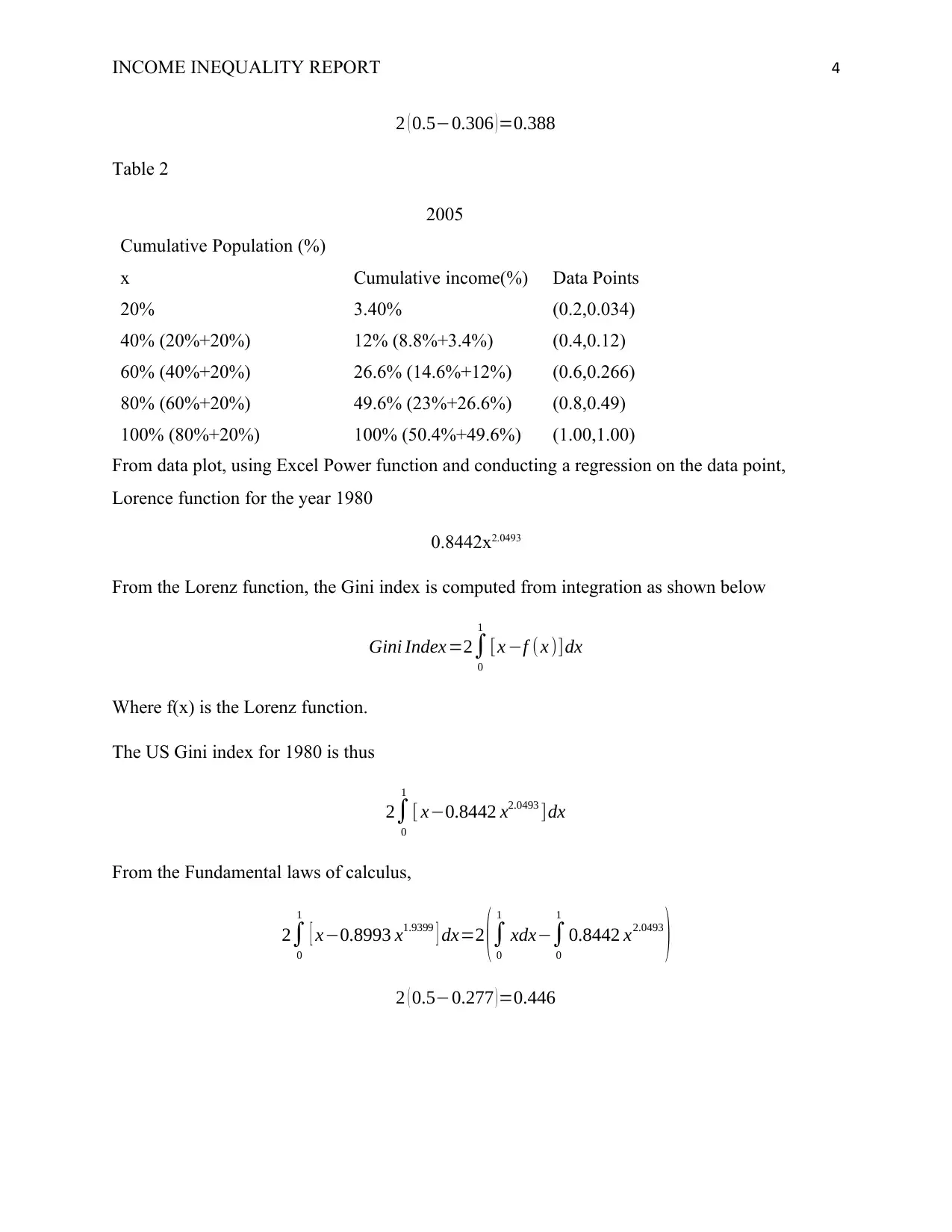
INCOME INEQUALITY REPORT 4
2 ( 0.5−0.306 )=0.388
Table 2
2005
Cumulative Population (%)
x Cumulative income(%) Data Points
20% 3.40% (0.2,0.034)
40% (20%+20%) 12% (8.8%+3.4%) (0.4,0.12)
60% (40%+20%) 26.6% (14.6%+12%) (0.6,0.266)
80% (60%+20%) 49.6% (23%+26.6%) (0.8,0.49)
100% (80%+20%) 100% (50.4%+49.6%) (1.00,1.00)
From data plot, using Excel Power function and conducting a regression on the data point,
Lorence function for the year 1980
0.8442x2.0493
From the Lorenz function, the Gini index is computed from integration as shown below
Gini Index=2∫
0
1
[x −f (x )]dx
Where f(x) is the Lorenz function.
The US Gini index for 1980 is thus
2∫
0
1
[ x−0.8442 x2.0493 ]dx
From the Fundamental laws of calculus,
2∫
0
1
[ x−0.8993 x1.9399 ] dx=2 (∫
0
1
xdx−∫
0
1
0.8442 x2.0493
)
2 ( 0.5−0.277 ) =0.446
2 ( 0.5−0.306 )=0.388
Table 2
2005
Cumulative Population (%)
x Cumulative income(%) Data Points
20% 3.40% (0.2,0.034)
40% (20%+20%) 12% (8.8%+3.4%) (0.4,0.12)
60% (40%+20%) 26.6% (14.6%+12%) (0.6,0.266)
80% (60%+20%) 49.6% (23%+26.6%) (0.8,0.49)
100% (80%+20%) 100% (50.4%+49.6%) (1.00,1.00)
From data plot, using Excel Power function and conducting a regression on the data point,
Lorence function for the year 1980
0.8442x2.0493
From the Lorenz function, the Gini index is computed from integration as shown below
Gini Index=2∫
0
1
[x −f (x )]dx
Where f(x) is the Lorenz function.
The US Gini index for 1980 is thus
2∫
0
1
[ x−0.8442 x2.0493 ]dx
From the Fundamental laws of calculus,
2∫
0
1
[ x−0.8993 x1.9399 ] dx=2 (∫
0
1
xdx−∫
0
1
0.8442 x2.0493
)
2 ( 0.5−0.277 ) =0.446
Paraphrase This Document
Need a fresh take? Get an instant paraphrase of this document with our AI Paraphraser

INCOME INEQUALITY REPORT 5
0 0.1 0.2 0.3 0.4 0.5 0.6 0.7 0.8 0.9 1
0
0.1
0.2
0.3
0.4
0.5
0.6
0.7
0.8
0.9
1
US Lorenz Curve for the Year 1970
Equality Line (45 degrees)
Lorenz Curve
Population (Cummulative Ranked)
National Income (Cummulative value)
0 0.1 0.2 0.3 0.4 0.5 0.6 0.7 0.8 0.9 1
0
0.1
0.2
0.3
0.4
0.5
0.6
0.7
0.8
0.9
1 US Lorenz Curve for the Year 1980
Equality Line (45 Degrees)
Lorenz Curve
Population (Cummulative Ranked)
National Income (Cummulative Value)
0 0.1 0.2 0.3 0.4 0.5 0.6 0.7 0.8 0.9 1
0
0.1
0.2
0.3
0.4
0.5
0.6
0.7
0.8
0.9
1
US Lorenz Curve for the Year 1970
Equality Line (45 degrees)
Lorenz Curve
Population (Cummulative Ranked)
National Income (Cummulative value)
0 0.1 0.2 0.3 0.4 0.5 0.6 0.7 0.8 0.9 1
0
0.1
0.2
0.3
0.4
0.5
0.6
0.7
0.8
0.9
1 US Lorenz Curve for the Year 1980
Equality Line (45 Degrees)
Lorenz Curve
Population (Cummulative Ranked)
National Income (Cummulative Value)
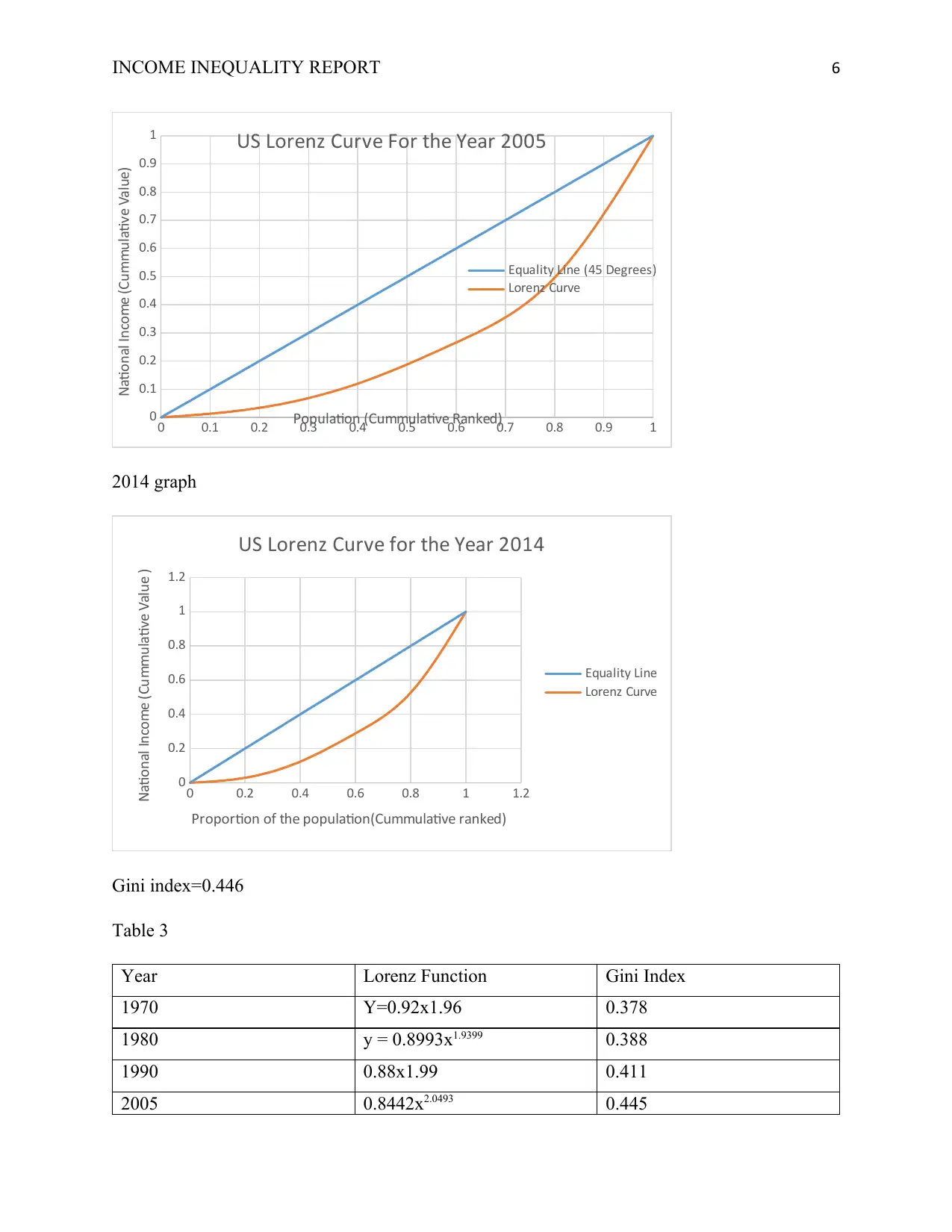
INCOME INEQUALITY REPORT 6
0 0.1 0.2 0.3 0.4 0.5 0.6 0.7 0.8 0.9 1
0
0.1
0.2
0.3
0.4
0.5
0.6
0.7
0.8
0.9
1 US Lorenz Curve For the Year 2005
Equality Line (45 Degrees)
Lorenz Curve
Population (Cummulative Ranked)
National Income (Cummulative Value)
2014 graph
0 0.2 0.4 0.6 0.8 1 1.2
0
0.2
0.4
0.6
0.8
1
1.2
US Lorenz Curve for the Year 2014
Equality Line
Lorenz Curve
Proportion of the population(Cummulative ranked)
National Income (Cummulative Value )
Gini index=0.446
Table 3
Year Lorenz Function Gini Index
1970 Y=0.92x1.96 0.378
1980 y = 0.8993x1.9399 0.388
1990 0.88x1.99 0.411
2005 0.8442x2.0493 0.445
0 0.1 0.2 0.3 0.4 0.5 0.6 0.7 0.8 0.9 1
0
0.1
0.2
0.3
0.4
0.5
0.6
0.7
0.8
0.9
1 US Lorenz Curve For the Year 2005
Equality Line (45 Degrees)
Lorenz Curve
Population (Cummulative Ranked)
National Income (Cummulative Value)
2014 graph
0 0.2 0.4 0.6 0.8 1 1.2
0
0.2
0.4
0.6
0.8
1
1.2
US Lorenz Curve for the Year 2014
Equality Line
Lorenz Curve
Proportion of the population(Cummulative ranked)
National Income (Cummulative Value )
Gini index=0.446
Table 3
Year Lorenz Function Gini Index
1970 Y=0.92x1.96 0.378
1980 y = 0.8993x1.9399 0.388
1990 0.88x1.99 0.411
2005 0.8442x2.0493 0.445
⊘ This is a preview!⊘
Do you want full access?
Subscribe today to unlock all pages.

Trusted by 1+ million students worldwide

INCOME INEQUALITY REPORT 7
2012 y = 0.84x2.09 0.456
2014 Y=0.84x2.09 0.479
Comparison of US income Inequalities between 1970 and 2014 from the Gini Indexes.
From the Gini indexes in table 3, income inequality in the US increased between 1970 and 2014.
This is indicated by the general increase in the Gini indices over the year, an increase from 0.378
in 1970 to 0.479 in 2014. The time serial index from 1970 however indicates some slight
instantaneous decline in the Gini index.
Global Data
Country 1970 (Gini Index) 2005 (Gini Index)
France 0.3582 0.2898
Finland 0.27 (1971) 0.259
2012 y = 0.84x2.09 0.456
2014 Y=0.84x2.09 0.479
Comparison of US income Inequalities between 1970 and 2014 from the Gini Indexes.
From the Gini indexes in table 3, income inequality in the US increased between 1970 and 2014.
This is indicated by the general increase in the Gini indices over the year, an increase from 0.378
in 1970 to 0.479 in 2014. The time serial index from 1970 however indicates some slight
instantaneous decline in the Gini index.
Global Data
Country 1970 (Gini Index) 2005 (Gini Index)
France 0.3582 0.2898
Finland 0.27 (1971) 0.259
Paraphrase This Document
Need a fresh take? Get an instant paraphrase of this document with our AI Paraphraser
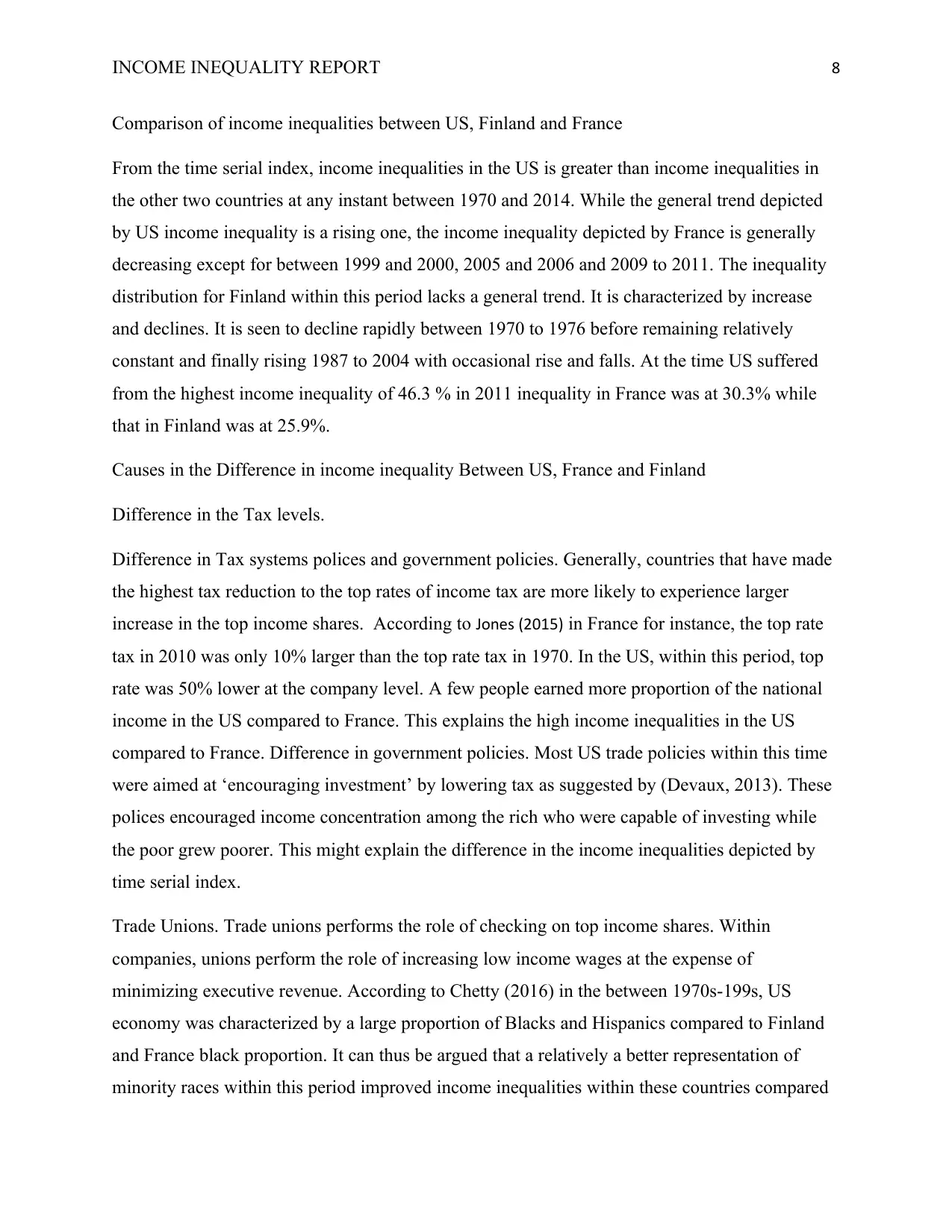
INCOME INEQUALITY REPORT 8
Comparison of income inequalities between US, Finland and France
From the time serial index, income inequalities in the US is greater than income inequalities in
the other two countries at any instant between 1970 and 2014. While the general trend depicted
by US income inequality is a rising one, the income inequality depicted by France is generally
decreasing except for between 1999 and 2000, 2005 and 2006 and 2009 to 2011. The inequality
distribution for Finland within this period lacks a general trend. It is characterized by increase
and declines. It is seen to decline rapidly between 1970 to 1976 before remaining relatively
constant and finally rising 1987 to 2004 with occasional rise and falls. At the time US suffered
from the highest income inequality of 46.3 % in 2011 inequality in France was at 30.3% while
that in Finland was at 25.9%.
Causes in the Difference in income inequality Between US, France and Finland
Difference in the Tax levels.
Difference in Tax systems polices and government policies. Generally, countries that have made
the highest tax reduction to the top rates of income tax are more likely to experience larger
increase in the top income shares. According to Jones (2015) in France for instance, the top rate
tax in 2010 was only 10% larger than the top rate tax in 1970. In the US, within this period, top
rate was 50% lower at the company level. A few people earned more proportion of the national
income in the US compared to France. This explains the high income inequalities in the US
compared to France. Difference in government policies. Most US trade policies within this time
were aimed at ‘encouraging investment’ by lowering tax as suggested by (Devaux, 2013). These
polices encouraged income concentration among the rich who were capable of investing while
the poor grew poorer. This might explain the difference in the income inequalities depicted by
time serial index.
Trade Unions. Trade unions performs the role of checking on top income shares. Within
companies, unions perform the role of increasing low income wages at the expense of
minimizing executive revenue. According to Chetty (2016) in the between 1970s-199s, US
economy was characterized by a large proportion of Blacks and Hispanics compared to Finland
and France black proportion. It can thus be argued that a relatively a better representation of
minority races within this period improved income inequalities within these countries compared
Comparison of income inequalities between US, Finland and France
From the time serial index, income inequalities in the US is greater than income inequalities in
the other two countries at any instant between 1970 and 2014. While the general trend depicted
by US income inequality is a rising one, the income inequality depicted by France is generally
decreasing except for between 1999 and 2000, 2005 and 2006 and 2009 to 2011. The inequality
distribution for Finland within this period lacks a general trend. It is characterized by increase
and declines. It is seen to decline rapidly between 1970 to 1976 before remaining relatively
constant and finally rising 1987 to 2004 with occasional rise and falls. At the time US suffered
from the highest income inequality of 46.3 % in 2011 inequality in France was at 30.3% while
that in Finland was at 25.9%.
Causes in the Difference in income inequality Between US, France and Finland
Difference in the Tax levels.
Difference in Tax systems polices and government policies. Generally, countries that have made
the highest tax reduction to the top rates of income tax are more likely to experience larger
increase in the top income shares. According to Jones (2015) in France for instance, the top rate
tax in 2010 was only 10% larger than the top rate tax in 1970. In the US, within this period, top
rate was 50% lower at the company level. A few people earned more proportion of the national
income in the US compared to France. This explains the high income inequalities in the US
compared to France. Difference in government policies. Most US trade policies within this time
were aimed at ‘encouraging investment’ by lowering tax as suggested by (Devaux, 2013). These
polices encouraged income concentration among the rich who were capable of investing while
the poor grew poorer. This might explain the difference in the income inequalities depicted by
time serial index.
Trade Unions. Trade unions performs the role of checking on top income shares. Within
companies, unions perform the role of increasing low income wages at the expense of
minimizing executive revenue. According to Chetty (2016) in the between 1970s-199s, US
economy was characterized by a large proportion of Blacks and Hispanics compared to Finland
and France black proportion. It can thus be argued that a relatively a better representation of
minority races within this period improved income inequalities within these countries compared
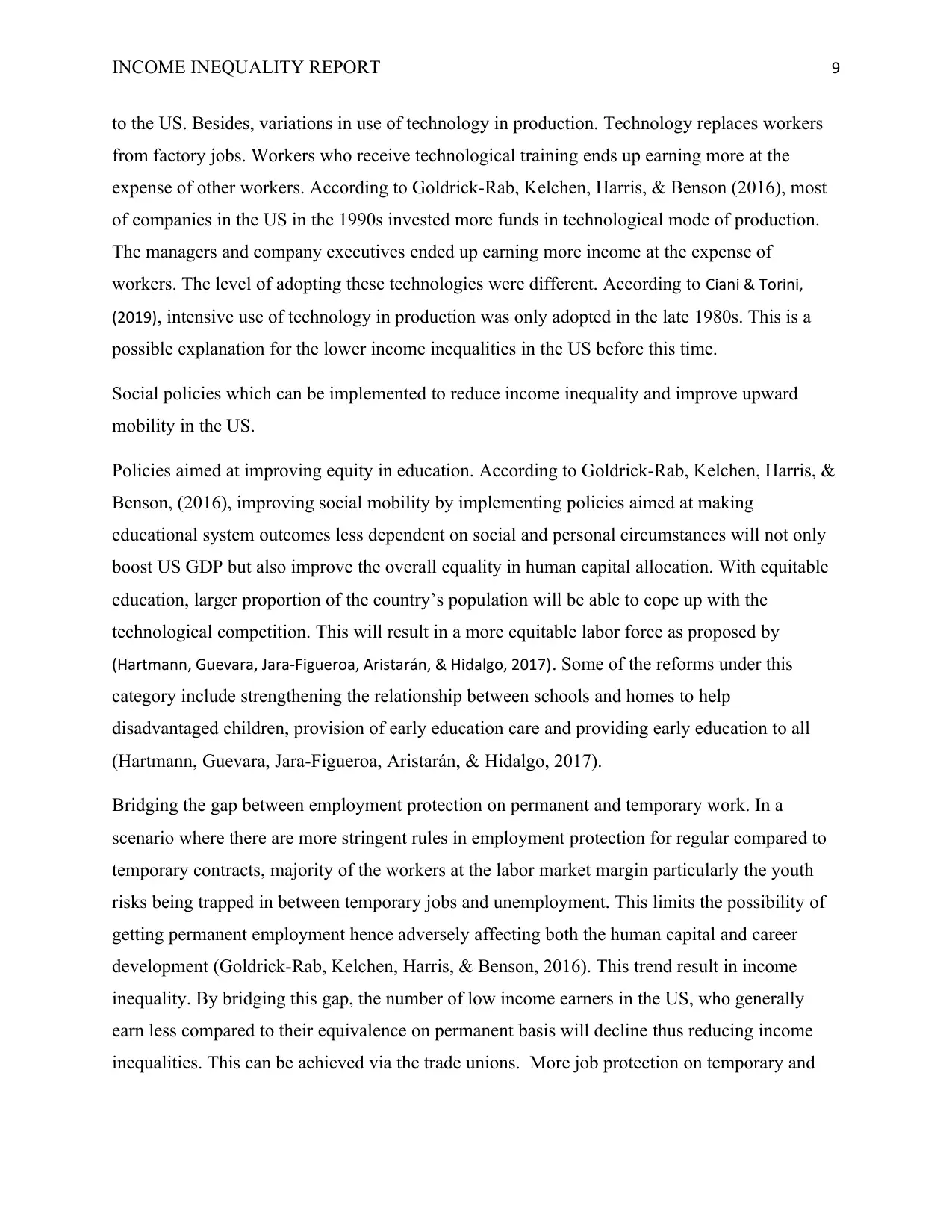
INCOME INEQUALITY REPORT 9
to the US. Besides, variations in use of technology in production. Technology replaces workers
from factory jobs. Workers who receive technological training ends up earning more at the
expense of other workers. According to Goldrick-Rab, Kelchen, Harris, & Benson (2016), most
of companies in the US in the 1990s invested more funds in technological mode of production.
The managers and company executives ended up earning more income at the expense of
workers. The level of adopting these technologies were different. According to Ciani & Torini,
(2019), intensive use of technology in production was only adopted in the late 1980s. This is a
possible explanation for the lower income inequalities in the US before this time.
Social policies which can be implemented to reduce income inequality and improve upward
mobility in the US.
Policies aimed at improving equity in education. According to Goldrick-Rab, Kelchen, Harris, &
Benson, (2016), improving social mobility by implementing policies aimed at making
educational system outcomes less dependent on social and personal circumstances will not only
boost US GDP but also improve the overall equality in human capital allocation. With equitable
education, larger proportion of the country’s population will be able to cope up with the
technological competition. This will result in a more equitable labor force as proposed by
(Hartmann, Guevara, Jara-Figueroa, Aristarán, & Hidalgo, 2017). Some of the reforms under this
category include strengthening the relationship between schools and homes to help
disadvantaged children, provision of early education care and providing early education to all
(Hartmann, Guevara, Jara-Figueroa, Aristarán, & Hidalgo, 2017).
Bridging the gap between employment protection on permanent and temporary work. In a
scenario where there are more stringent rules in employment protection for regular compared to
temporary contracts, majority of the workers at the labor market margin particularly the youth
risks being trapped in between temporary jobs and unemployment. This limits the possibility of
getting permanent employment hence adversely affecting both the human capital and career
development (Goldrick-Rab, Kelchen, Harris, & Benson, 2016). This trend result in income
inequality. By bridging this gap, the number of low income earners in the US, who generally
earn less compared to their equivalence on permanent basis will decline thus reducing income
inequalities. This can be achieved via the trade unions. More job protection on temporary and
to the US. Besides, variations in use of technology in production. Technology replaces workers
from factory jobs. Workers who receive technological training ends up earning more at the
expense of other workers. According to Goldrick-Rab, Kelchen, Harris, & Benson (2016), most
of companies in the US in the 1990s invested more funds in technological mode of production.
The managers and company executives ended up earning more income at the expense of
workers. The level of adopting these technologies were different. According to Ciani & Torini,
(2019), intensive use of technology in production was only adopted in the late 1980s. This is a
possible explanation for the lower income inequalities in the US before this time.
Social policies which can be implemented to reduce income inequality and improve upward
mobility in the US.
Policies aimed at improving equity in education. According to Goldrick-Rab, Kelchen, Harris, &
Benson, (2016), improving social mobility by implementing policies aimed at making
educational system outcomes less dependent on social and personal circumstances will not only
boost US GDP but also improve the overall equality in human capital allocation. With equitable
education, larger proportion of the country’s population will be able to cope up with the
technological competition. This will result in a more equitable labor force as proposed by
(Hartmann, Guevara, Jara-Figueroa, Aristarán, & Hidalgo, 2017). Some of the reforms under this
category include strengthening the relationship between schools and homes to help
disadvantaged children, provision of early education care and providing early education to all
(Hartmann, Guevara, Jara-Figueroa, Aristarán, & Hidalgo, 2017).
Bridging the gap between employment protection on permanent and temporary work. In a
scenario where there are more stringent rules in employment protection for regular compared to
temporary contracts, majority of the workers at the labor market margin particularly the youth
risks being trapped in between temporary jobs and unemployment. This limits the possibility of
getting permanent employment hence adversely affecting both the human capital and career
development (Goldrick-Rab, Kelchen, Harris, & Benson, 2016). This trend result in income
inequality. By bridging this gap, the number of low income earners in the US, who generally
earn less compared to their equivalence on permanent basis will decline thus reducing income
inequalities. This can be achieved via the trade unions. More job protection on temporary and
⊘ This is a preview!⊘
Do you want full access?
Subscribe today to unlock all pages.

Trusted by 1+ million students worldwide
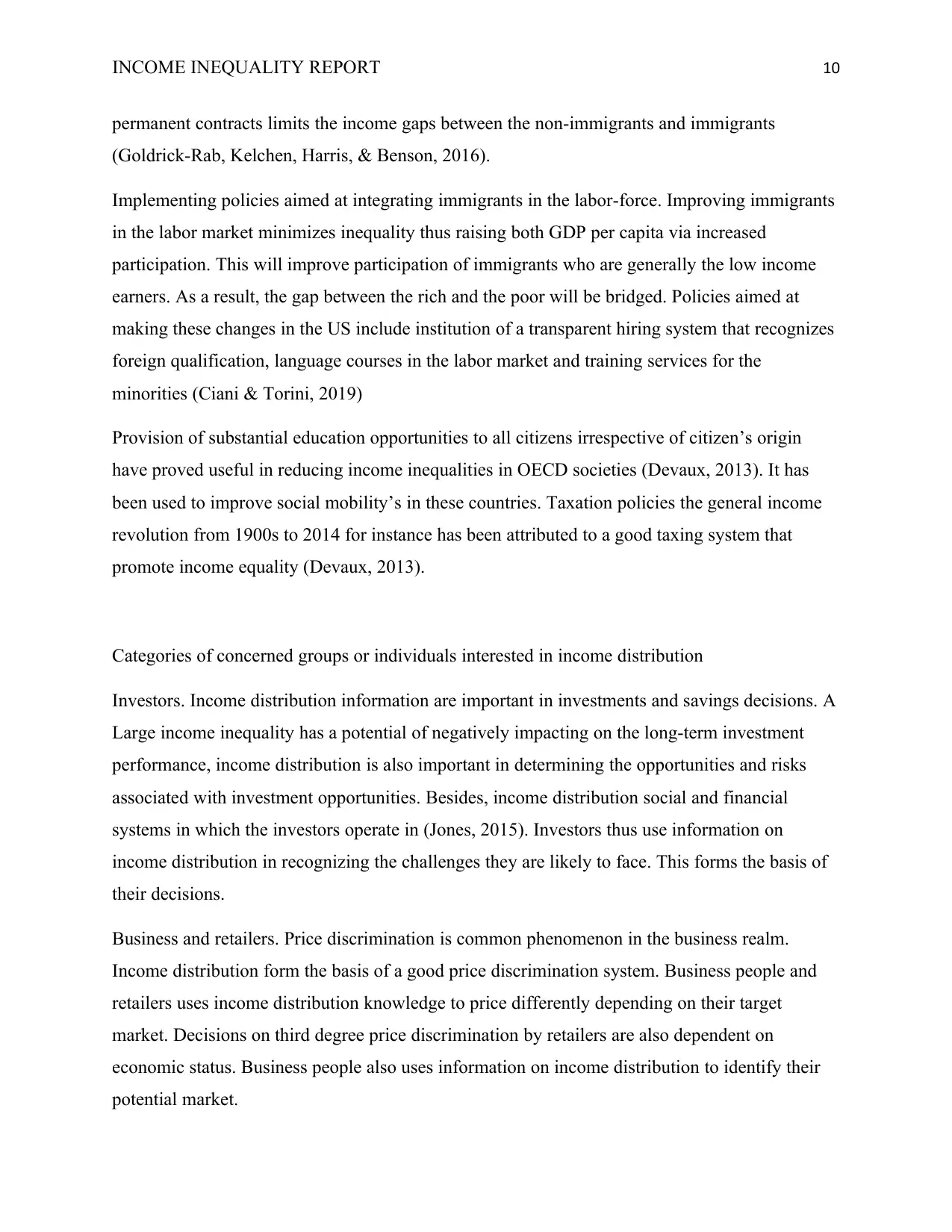
INCOME INEQUALITY REPORT 10
permanent contracts limits the income gaps between the non-immigrants and immigrants
(Goldrick-Rab, Kelchen, Harris, & Benson, 2016).
Implementing policies aimed at integrating immigrants in the labor-force. Improving immigrants
in the labor market minimizes inequality thus raising both GDP per capita via increased
participation. This will improve participation of immigrants who are generally the low income
earners. As a result, the gap between the rich and the poor will be bridged. Policies aimed at
making these changes in the US include institution of a transparent hiring system that recognizes
foreign qualification, language courses in the labor market and training services for the
minorities (Ciani & Torini, 2019)
Provision of substantial education opportunities to all citizens irrespective of citizen’s origin
have proved useful in reducing income inequalities in OECD societies (Devaux, 2013). It has
been used to improve social mobility’s in these countries. Taxation policies the general income
revolution from 1900s to 2014 for instance has been attributed to a good taxing system that
promote income equality (Devaux, 2013).
Categories of concerned groups or individuals interested in income distribution
Investors. Income distribution information are important in investments and savings decisions. A
Large income inequality has a potential of negatively impacting on the long-term investment
performance, income distribution is also important in determining the opportunities and risks
associated with investment opportunities. Besides, income distribution social and financial
systems in which the investors operate in (Jones, 2015). Investors thus use information on
income distribution in recognizing the challenges they are likely to face. This forms the basis of
their decisions.
Business and retailers. Price discrimination is common phenomenon in the business realm.
Income distribution form the basis of a good price discrimination system. Business people and
retailers uses income distribution knowledge to price differently depending on their target
market. Decisions on third degree price discrimination by retailers are also dependent on
economic status. Business people also uses information on income distribution to identify their
potential market.
permanent contracts limits the income gaps between the non-immigrants and immigrants
(Goldrick-Rab, Kelchen, Harris, & Benson, 2016).
Implementing policies aimed at integrating immigrants in the labor-force. Improving immigrants
in the labor market minimizes inequality thus raising both GDP per capita via increased
participation. This will improve participation of immigrants who are generally the low income
earners. As a result, the gap between the rich and the poor will be bridged. Policies aimed at
making these changes in the US include institution of a transparent hiring system that recognizes
foreign qualification, language courses in the labor market and training services for the
minorities (Ciani & Torini, 2019)
Provision of substantial education opportunities to all citizens irrespective of citizen’s origin
have proved useful in reducing income inequalities in OECD societies (Devaux, 2013). It has
been used to improve social mobility’s in these countries. Taxation policies the general income
revolution from 1900s to 2014 for instance has been attributed to a good taxing system that
promote income equality (Devaux, 2013).
Categories of concerned groups or individuals interested in income distribution
Investors. Income distribution information are important in investments and savings decisions. A
Large income inequality has a potential of negatively impacting on the long-term investment
performance, income distribution is also important in determining the opportunities and risks
associated with investment opportunities. Besides, income distribution social and financial
systems in which the investors operate in (Jones, 2015). Investors thus use information on
income distribution in recognizing the challenges they are likely to face. This forms the basis of
their decisions.
Business and retailers. Price discrimination is common phenomenon in the business realm.
Income distribution form the basis of a good price discrimination system. Business people and
retailers uses income distribution knowledge to price differently depending on their target
market. Decisions on third degree price discrimination by retailers are also dependent on
economic status. Business people also uses information on income distribution to identify their
potential market.
Paraphrase This Document
Need a fresh take? Get an instant paraphrase of this document with our AI Paraphraser
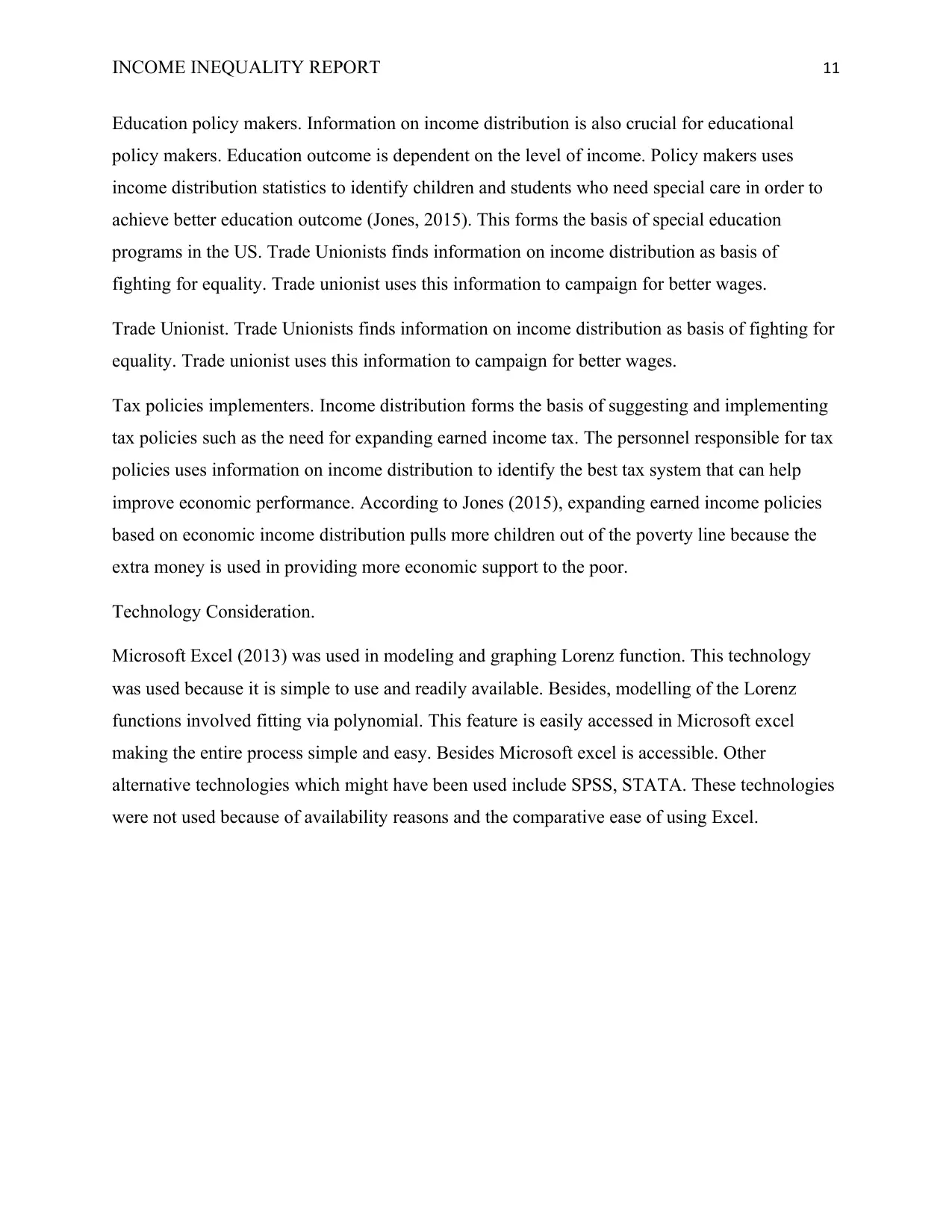
INCOME INEQUALITY REPORT 11
Education policy makers. Information on income distribution is also crucial for educational
policy makers. Education outcome is dependent on the level of income. Policy makers uses
income distribution statistics to identify children and students who need special care in order to
achieve better education outcome (Jones, 2015). This forms the basis of special education
programs in the US. Trade Unionists finds information on income distribution as basis of
fighting for equality. Trade unionist uses this information to campaign for better wages.
Trade Unionist. Trade Unionists finds information on income distribution as basis of fighting for
equality. Trade unionist uses this information to campaign for better wages.
Tax policies implementers. Income distribution forms the basis of suggesting and implementing
tax policies such as the need for expanding earned income tax. The personnel responsible for tax
policies uses information on income distribution to identify the best tax system that can help
improve economic performance. According to Jones (2015), expanding earned income policies
based on economic income distribution pulls more children out of the poverty line because the
extra money is used in providing more economic support to the poor.
Technology Consideration.
Microsoft Excel (2013) was used in modeling and graphing Lorenz function. This technology
was used because it is simple to use and readily available. Besides, modelling of the Lorenz
functions involved fitting via polynomial. This feature is easily accessed in Microsoft excel
making the entire process simple and easy. Besides Microsoft excel is accessible. Other
alternative technologies which might have been used include SPSS, STATA. These technologies
were not used because of availability reasons and the comparative ease of using Excel.
Education policy makers. Information on income distribution is also crucial for educational
policy makers. Education outcome is dependent on the level of income. Policy makers uses
income distribution statistics to identify children and students who need special care in order to
achieve better education outcome (Jones, 2015). This forms the basis of special education
programs in the US. Trade Unionists finds information on income distribution as basis of
fighting for equality. Trade unionist uses this information to campaign for better wages.
Trade Unionist. Trade Unionists finds information on income distribution as basis of fighting for
equality. Trade unionist uses this information to campaign for better wages.
Tax policies implementers. Income distribution forms the basis of suggesting and implementing
tax policies such as the need for expanding earned income tax. The personnel responsible for tax
policies uses information on income distribution to identify the best tax system that can help
improve economic performance. According to Jones (2015), expanding earned income policies
based on economic income distribution pulls more children out of the poverty line because the
extra money is used in providing more economic support to the poor.
Technology Consideration.
Microsoft Excel (2013) was used in modeling and graphing Lorenz function. This technology
was used because it is simple to use and readily available. Besides, modelling of the Lorenz
functions involved fitting via polynomial. This feature is easily accessed in Microsoft excel
making the entire process simple and easy. Besides Microsoft excel is accessible. Other
alternative technologies which might have been used include SPSS, STATA. These technologies
were not used because of availability reasons and the comparative ease of using Excel.
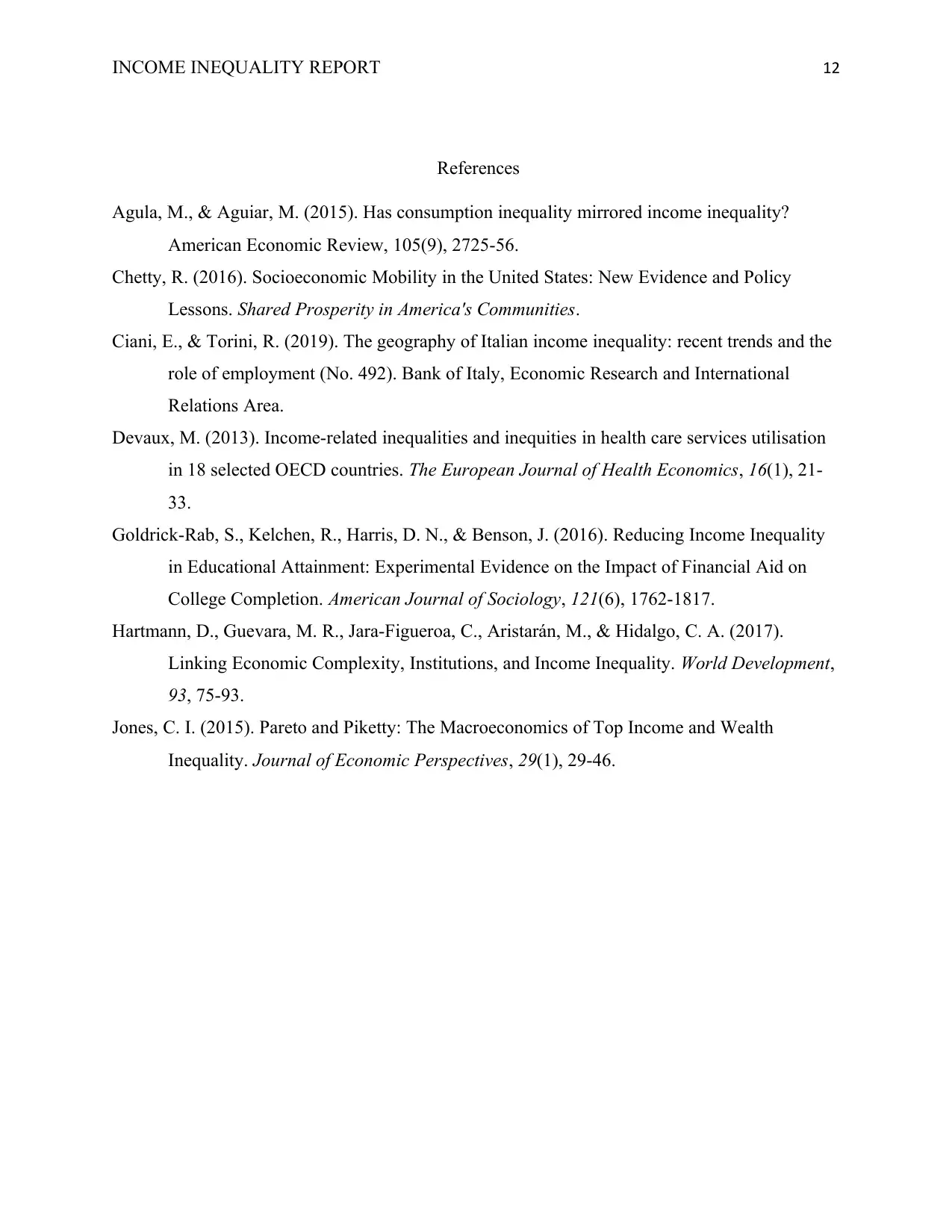
INCOME INEQUALITY REPORT 12
References
Agula, M., & Aguiar, M. (2015). Has consumption inequality mirrored income inequality?
American Economic Review, 105(9), 2725-56.
Chetty, R. (2016). Socioeconomic Mobility in the United States: New Evidence and Policy
Lessons. Shared Prosperity in America's Communities.
Ciani, E., & Torini, R. (2019). The geography of Italian income inequality: recent trends and the
role of employment (No. 492). Bank of Italy, Economic Research and International
Relations Area.
Devaux, M. (2013). Income-related inequalities and inequities in health care services utilisation
in 18 selected OECD countries. The European Journal of Health Economics, 16(1), 21-
33.
Goldrick-Rab, S., Kelchen, R., Harris, D. N., & Benson, J. (2016). Reducing Income Inequality
in Educational Attainment: Experimental Evidence on the Impact of Financial Aid on
College Completion. American Journal of Sociology, 121(6), 1762-1817.
Hartmann, D., Guevara, M. R., Jara-Figueroa, C., Aristarán, M., & Hidalgo, C. A. (2017).
Linking Economic Complexity, Institutions, and Income Inequality. World Development,
93, 75-93.
Jones, C. I. (2015). Pareto and Piketty: The Macroeconomics of Top Income and Wealth
Inequality. Journal of Economic Perspectives, 29(1), 29-46.
References
Agula, M., & Aguiar, M. (2015). Has consumption inequality mirrored income inequality?
American Economic Review, 105(9), 2725-56.
Chetty, R. (2016). Socioeconomic Mobility in the United States: New Evidence and Policy
Lessons. Shared Prosperity in America's Communities.
Ciani, E., & Torini, R. (2019). The geography of Italian income inequality: recent trends and the
role of employment (No. 492). Bank of Italy, Economic Research and International
Relations Area.
Devaux, M. (2013). Income-related inequalities and inequities in health care services utilisation
in 18 selected OECD countries. The European Journal of Health Economics, 16(1), 21-
33.
Goldrick-Rab, S., Kelchen, R., Harris, D. N., & Benson, J. (2016). Reducing Income Inequality
in Educational Attainment: Experimental Evidence on the Impact of Financial Aid on
College Completion. American Journal of Sociology, 121(6), 1762-1817.
Hartmann, D., Guevara, M. R., Jara-Figueroa, C., Aristarán, M., & Hidalgo, C. A. (2017).
Linking Economic Complexity, Institutions, and Income Inequality. World Development,
93, 75-93.
Jones, C. I. (2015). Pareto and Piketty: The Macroeconomics of Top Income and Wealth
Inequality. Journal of Economic Perspectives, 29(1), 29-46.
⊘ This is a preview!⊘
Do you want full access?
Subscribe today to unlock all pages.

Trusted by 1+ million students worldwide
1 out of 12
Related Documents
Your All-in-One AI-Powered Toolkit for Academic Success.
+13062052269
info@desklib.com
Available 24*7 on WhatsApp / Email
![[object Object]](/_next/static/media/star-bottom.7253800d.svg)
Unlock your academic potential
Copyright © 2020–2025 A2Z Services. All Rights Reserved. Developed and managed by ZUCOL.




